Jesse Siegel
Head of U.S. Business Ethics
If you ask Caitlin about her dad, Robert, you’ll see a huge smile spread across her face. She describes him as her “favorite person in the whole world.” Throughout her childhood, he always supported her interests, from driving her to every early morning hockey practice (rain, shine or snow), to instilling a lifelong love of reading that she would carry into her career as an editor. When he started taking her to baseball games, it became a tradition they would carry on for years to come.
For Robert, his love of baseball was deep. He loved watching games at home or bringing his family to root for his favorite team, the Boston Red Sox. But his favorite thing about baseball was that it is a sport that anyone can play. He always said, “all you need is a stick and a patch of dirt.”
A difficult diagnosis
In 2012, Robert went to the hospital with stomach pain. Doctors saw that he was also experiencing yellowing of his skin, known as jaundice. Seeing these symptoms together, doctors ordered tests, which revealed pancreatic ductal adenocarcinoma, an aggressive form of pancreatic cancer known to have poor outcomes.
Caitlin recalls she was in her final year at college when doctors told her mom that her father would be “lucky to see Christmas” and that the family needed to “settle his affairs.” When she first heard the prognosis, Caitlin thought, “that is not possible. My dad has to be at my graduation in May – he needs more time than that.” She knew that her family would fight for more time.
Choosing more time
Armed with optimism, the family decided to seek out care to extend their time together. They met with an oncologist who proposed a treatment plan. After consideration of the risks and benefits, they decided to move forward with the plan. Caitlin describes the feeling as, “we went from having no time at all to having more time and more hope.”
In 2013, Caitlin’s dad got a clean scan. Describing this moment, Caitlin beams with joy knowing her dad would be able to attend her graduation – a huge milestone in her life. However, four and a half years after his diagnosis, Robert started to have trouble walking. The cancer had spread and doctors predicted he would only have one week to live. But, once again defying the odds, the family had five and a half more weeks together. They continued to make the most of each moment, including baseball opening day together in the living room, when Caitlin decorated with balloons. It’s a core memory Caitlin will forever hold close to her heart.
Honoring her dad’s memory
Instead of focusing on the time she didn’t have, Caitlin focuses on the memories she made with her dad. She is now a volunteer advocate for the Pancreatic Cancer Action Network (PanCAN), an advocacy organization dedicated to supporting people impacted by pancreatic cancer.
Caitlin also carries with her the sage advice from her father “Life is just going to keep throwing things at you. So, pick up a bat, and hit back. Keep swinging.”
If you or someone you know is impacted by pancreatic cancer, visit panCAN.org for resources.
Caitlin was compensated for her time by Ipsen.
NON-US-003911. November 2024.
It’s no secret that the biotech and pharma industries are highly regulated and for very good reason. We have an important role to play in ensuring new, innovative medicines reach the people who need them. But the rules that govern our industry are complex – so, to help navigate these complexities, most pharmaceutical companies operating in the United States have a robust compliance program. Ipsen is no different. However, an effective compliance program doesn’t just ensure our compliance with rules and regulations – it also allows our Ipsen colleagues to better focus on our goals and retain trust with the communities we serve.
In recognition of Corporate Compliance & Ethics Week (November 3-9), Jesse Siegel, Head of U.S. Business Ethics at Ipsen, reflects on 5 key components of our strong compliance culture and how we navigate an ever-evolving industry landscape.
As Head of U.S. Business Ethics at Ipsen, I lead a team that considers the latest laws and guidance from the U.S. government so that we can minimize potential risk in our day-to-day activities and strategic initiatives. To ensure Ipsen’s compliance across all activities, we serve in an advisory capacity to our stakeholders across the business. This means we’re integrated into key discussions from the beginning, so that our guidance can be accounted for early in the planning phase of various initiatives that may touch healthcare providers, patients, caregivers, patient advocacy organizations and the wider healthcare community.
We have an expectation that compliance is something everyone across the organization takes ownership for. This dynamic creates a culture of accountability and demonstrates our true commitment to compliance. As an example, suppose a team wants to embark on a new project or initiative. The Business Ethics team will review those plans and advise on risks and relevant guardrails. But it’s ultimately the team’s responsibility to put these recommendations into action – whether that’s by collaborating with Business Ethics on training (even taking the lead where appropriate), supporting monitoring efforts, or, most critically, by making the ultimate risk decision with our advice in mind.
Although we follow the rules from the U.S. government and take their guidance seriously, it’s important to understand that these things change over time. A compliance program is only effective when it can be nimble and ready to evolve with changing guidance and Ipsen’s evolving business. And it’s not only new guidance we have to be aware of but new technologies. One very prominent example is the growing impact of artificial intelligence (AI). This technology was already on our radar at Ipsen, but over the last year it’s taken the industry (and the world) by storm. Today’s compliance programs have to account for the potential risks of AI. At Ipsen, we’re already keeping a close watch to anticipate the next big technology wave that we’ll not only implement into our business, but in our approach to compliance, too.
Beyond compliance itself, Ipsen also prioritizes our ethics – which goes even deeper. Ethics means doing the right thing in all our interactions. In that sense, ethics certainly includes compliance, but it also means doing what is right and being mindful of how we show up for one another, patients, and the broader community. Here, too, our business colleagues play a crucial role. The Business Ethics team in the U.S. doesn’t own responsibility for ethics. Instead, we bring a unique perspective to conversations by raising viewpoints pertaining to ethics that our business colleagues can then consider.
Ultimately, it all comes down to doing the right thing. Staying vigilant and retaining a compliance culture go hand-in-hand with achieving our mission: staying focused and helping to improve outcomes for patients and society.
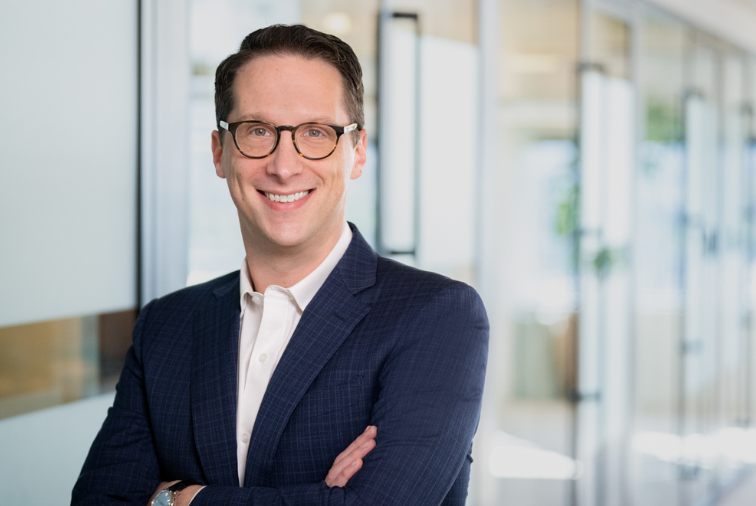
Head of U.S. Business Ethics
The past 30 years have brought significant innovations to the way cancer is diagnosed and treated, including for people with some of the most difficult-to-treat cancers. As scientific understanding has expanded, we now know what drives certain cancers through biomarker testing, which has allowed for personalized treatment to target specific mutations.
We are in the age of precision medicine in cancer – first targeted therapies, then immunotherapies and most recently CAR-Ts. The more we understand about the “basic science” of cancer, treatments will continue to become more precise and personalized. One example of this new frontier in research is the study of epigenetics, which is helping us meet cancer where it forms.
The study of epigenetics related to cancer dates back to the early 1980s. In simple terms, the field of epigenetics studies changes to DNA that impact gene expression. These epi changes are part of normal biological functioning that can be inherited or can occur in response to a person’s behavior or environment. However, unlike mutational genetic changes, epigenetic changes are dynamic and reversible, as they do not change the DNA sequence itself.i
Some epigenetic changes involve processes that cause cancer. Alterations to the chromatin structure can ‘switch on’ the expression of pro-cancer genes or silence genes in the body that would normally protect the body against cancer.ii
Since epigenetic changes are reversible and susceptible to external factors, they make promising targets.iii By understanding how and which epigenetic changes lead to cancer, scientists can develop treatments to target and modify these processes. And in doing so, epigenetic treatments might have less impact on overall quality of life or fewer associated side effects.i Research is also ongoing into the potential use of epigenetic changes as biomarkers for cancer diagnosis.
What do an engineer and an animal scientist have in common?
Dr. Lindsey Rodrigues, a biomedical engineer and cancer biologist by training, and Lindsey Eichinger, who has a background in veterinary sciences and cell biology, are two scientists at Ipsen who are leading the exploration of epigenetics – a new frontier for cancer research and the future of cancer care.
“I’ve always been fascinated with the concept of ‘drugging the undruggable’,” explains Dr. Rodrigues. “It is well known that proteins that modify the epigenome are dysregulated in cancer and many other diseases, yet historically, it has been difficult to develop medicines for these targets.”
This Ipsen research team starts with identifying these epigenetic drivers and understanding the mechanisms that drive cancer growth before finding how to switch it ‘on and off.’
“Our platform-based approach to discovery allows us to quickly leverage learnings and then apply them to new targets, biomarkers and diseases,” notes Dr. Rodrigues.
The team has been successful identifying epigenetic drivers of cancer and building innovative tools that allow them to find new medicines to target these epigenetic dependencies.
Across the bench collaboration
The backbone of this type of highly innovative scientific research is not just one brilliant mind – it’s multiple.
“One key to advancing science is knowing that two, three or four heads are better than one,” notes Eichinger. “In practice, this means taking a step back when solving a problem and actively seeking out other perspectives from colleagues. There can be many different ways to solve a puzzle. No two people will approach it with the same thinking.”
Uniquely, their diverse educational and career experiences – paired with a dynamic team of chemists, structural and computational biologists, pharmacologists, toxicologists and others – bring different skillsets that both complement and challenge one another.
“We foster a one-team approach where open dialogue and collaboration is valued. We believe that when one person on a team succeeds, so does the rest of the team,” states Dr. Rodrigues. “This helps encourage growth and support, rather than create silos and barriers that can exist in some research settings. As we look at the epigenetic platform and beyond to other treatment modalities, our team hopes better, bolder science continues to translate into medicines that help more people.”
While at the heart of the team’s work they are exploring how the epigenetic platform can improve patient outcomes, their “x-factor” is their unique across-the-bench collaboration.
“It’s the diversity of ideas and experiences that will be key to successfully bringing new epigenetic therapies to patients,” explains Eichinger.
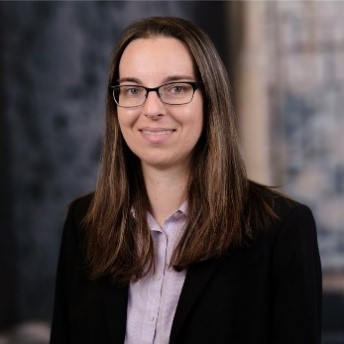
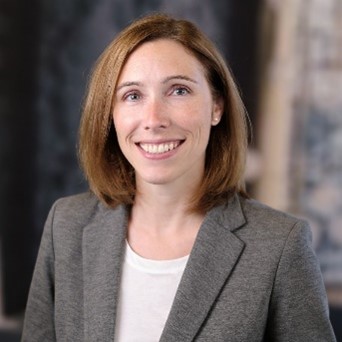
i Kelly TK, De Carvalho DD, Jones PA. Epigenetic modifications as therapeutic targets. Nat Biotechnol. 2010 Oct;28(10):1069-78. doi: 10.1038/nbt.1678. PMID: 20944599; PMCID: PMC3022972.
ii Baylin SB, Jones PA. Epigenetic Determinants of Cancer. Cold Spring Harb Perspect Biol 2016;8:a019505.
iii Lu Y, Chan YT, Tan HY, et al. Epigenetic regulation in human cancer: the potential role of epi-drug in cancer therapy. Mol Cancer 2020;19:79.
ALLSC-US-001404. May 2024
Randy loves to read, enjoy the outdoors, and spend time with his family. He enjoys going to the gym and took up aquatic therapy to exercise and make new friends. He’s come a long way since he experienced a car accident, which led to traumatic brain injury (TBI) and stroke-like symptoms as a result back in 2017. Recently, after seven years of outpatient physical rehabilitation, he has been discharged. I had the honor of speaking to him recently to hear how “Randy 2.0,” as he refers to himself, has transformed and how he is embracing his path forward.
Randy’s care journey
After the accident, Randy described waking up in the hospital like being in a foreign land. He didn’t recognize where he was or who was around him. Those early weeks in the hospital focused on regaining an understanding of who he was, and where he was. Although he was in a strange place, Randy was thankful to have support from his mother and godmother, who visited him every single morning.
After months in the hospital, he was evaluated for discharge by his care team. Together, they decided to transfer him to a long-term residential rehab facility where he could continue to work on his recovery journey, starting with small victories. For example, at the rehab facility, Randy worked on his motor skills – starting with building up the strength to sit up on the side of his bed for 12 seconds at a time.
Randy spent 19 months in the rehab facility before returning home. Once home, he continued to receive care and with his physical and occupational therapists, they developed a comprehensive strategy for him to continue making progress towards his goals. To accommodate his new mobility, his house required renovations to meet accessibility standards.
Impact of spasticity
Throughout his recovery journey, Randy has faced many obstacles, from regaining his strength, to adjusting to new family dynamics. One challenge included muscle tightness which he experienced on his left side, and his neurologist identified it as spasticity.
For Randy, spasticity impacts his arm, complicating daily tasks from opening a car door, to tying his shoes. Randy’s occupational therapy team reminds him to “just use it” – meaning using his left side for anything and everything from turning on a light to holding a toothbrush to improve mobility.
To help regain movement and strength to his affected side, Randy followed a schedule of physical therapy to improve his spasticity in addition to receiving targeted injections to help loosen the affected muscles. And he can tell when it’s time for a session when his left side feels tighter and harder to move. But with work and focus, things that were once difficult to do, like putting on deodorant by himself, he’s now able to do.
Getting back to what he loves
In my conversations with Randy, he has taught me that while every day has been a challenge, a positive mindset is everything. For Randy, that means reminding himself that progress doesn’t happen overnight – he focuses on the big picture, and how “the little moments” add up to progress.
By listening to his story, I’m also reminded about the importance of a strong care and support team that you can trust. Randy’s support network has been key to coaching and motivating him through exercises to regain range of motion – allowing him to focus on the future and what he can and will be able to do.
I admire that Randy has goals to take a walk across a five-mile bridge near his home, and to mow his own lawn, in addition to continuing to advocate for his community. Randy has also discovered a passion for helping others going through a similar experience. One way he does this is through volunteering his time to tell his story to medical students, so they can better understand what the recovery journey entails. For Randy, he knows how much perseverance the road to recovery takes. Whatever the future holds for Randy, I am certain he will embrace it with his “one day at a time” attitude.
Randy was compensated for his time by Ipsen.
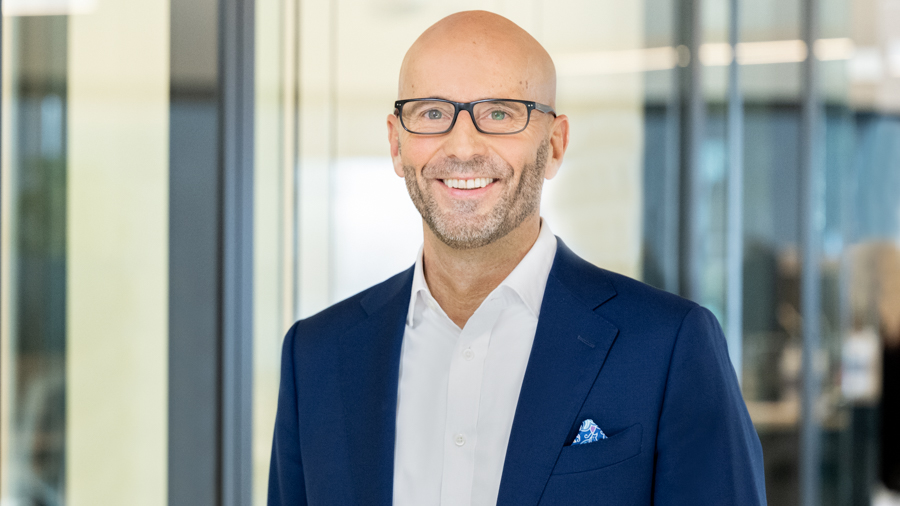
Vice President, Franchise Head, Neuroscience Business Unit
ALLSC-US-001309. May 2024
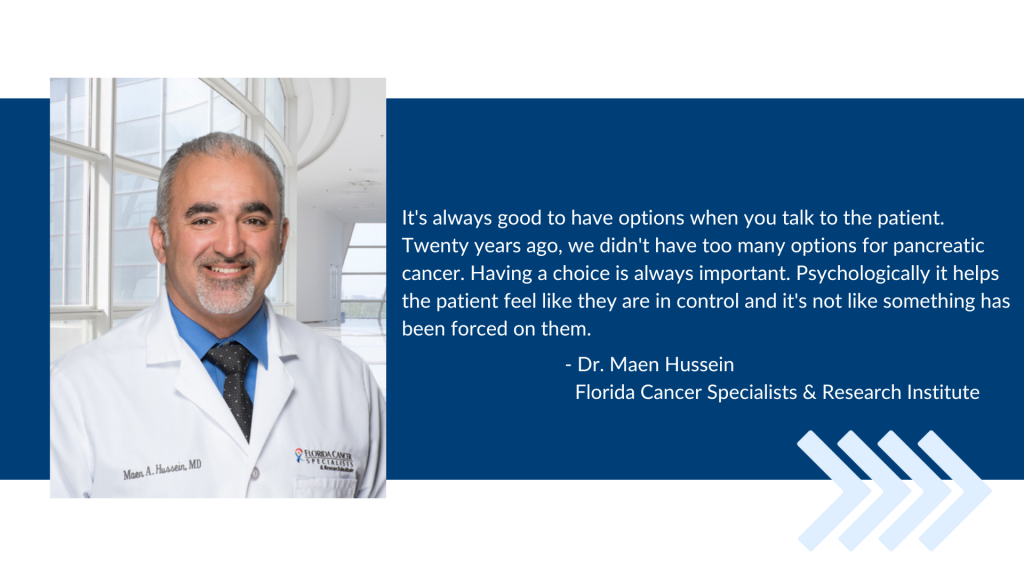
Emad Abdelnaby, Senior Vice President, Oncology Franchise Head at Ipsen shares learnings from Dr. Maen Hussein of Florida Cancer Specialists & Research Institute about his approach to treating pancreatic cancer
Nearly 25 years ago, the five-year survival rate for pancreatic cancer was just 5 percent, making it one of the most difficult cancers to treat with the poorest prognosis. Today, pancreatic cancer remains difficult to diagnose early and a hard-to-treat cancer with survival rates hovering around 13 percent. While incremental advancements have been made in the last decade, few patients benefit from this scientific progress. According to the Pancreatic Cancer Action Network, of the 60,000 people newly diagnosed with pancreatic cancer this year, 8,632 people will be able to enjoy life’s moments for five years – more birthdays to celebrate, more family vacations and more memories with friends.
In recent conversations with Dr. Maen Hussein of Florida Cancer Specialists & Research Insitute, our team learned about the progress he’s witnessed firsthand since his fellowship 20 years ago, including a recent FDA-approved regimen for the most advanced form of the disease. He also let us in on the evolution of attitudes and behaviors when it comes to treating people with pancreatic cancer and he shared some best practices he’s learned:
In a field where scientific progress has been slow, Dr. Hussein reminds us that a strong doctor-patient relationship also has the potential to shape outcomes and will ultimately create the best possible experience for patients. In tandem with continued innovation, this should make us all optimistic about the future of pancreatic cancer treatment.
Dr. Hussein was compensated for his time by Ipsen.
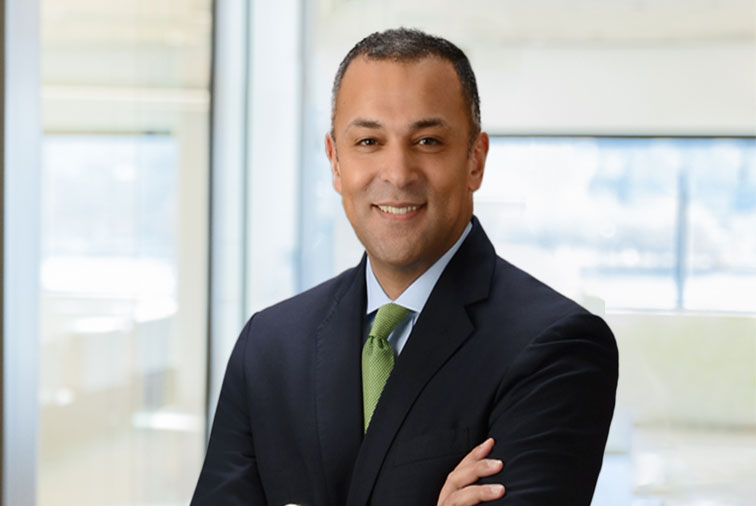
Senior Vice President, Franchise Head, Oncology Business Unit
Carli and Erin, cross-country best friends, discuss how they’ve realized the importance of a strong support network of immediate family and friends, along with people who have a shared experience of living with FOP. Their connections have been key to navigating how to retain their independence.
Carli and Erin are self-described best friends who coincidentally grew close despite living half a country apart. They are both in their 20s, they’re only-children with mothers named Lori, both have yellow Labrador retrievers, both are in long-term relationships – and both happen to have an ultra-rare disease called fibrodysplasia ossificans progressiva (FOP). FOP affects up to 400 people in the U.S. and causes permanent, continuous bone formation in soft and connective tissues.
The two have built an incredible support system of friends and family they lean on in different circumstances. Having a comprehensive support network beyond healthcare providers and immediate family can be so important for someone navigating life with an ultra-rare disease.
Seeking support
Erin kept relatively quiet about living with FOP up until she was around 18 years old and experienced a flare-up in her hip that impacted her mobility. Moving forward, she realized it was time for her to become more connected to others who may be going through the same thing. As a child, Erin had known others who were living with FOP and built friendships around “normal kid things, like clothes and crushes on boys.” Looking back, she wishes she leaned into these friendships more as a teen and embraced their similar experiences living with FOP.
“I remember, when I wanted to start driving, my mom reached out to some other Moms of young adults living with FOP and we received a lot of great feedback. For example, they shared what to look for in specific vehicles based on their experience driving and living with FOP,” Erin shared. “It’s also been helpful to connect with people on mobility tools, such as wheelchairs, specific for people with limited range of motion. Other people have been a great help for day-to-day recommendations on what cushions they may prefer or even mattresses.”
Similarly, Carli did not reconnect with people living with FOP until her independence diminished as a result of losing some functionality. She had experienced flare-ups that impacted her mobility and connected with others living with FOP to learn about the different adaptation tools to help her manage limitations to retain independence. In a scary time when her body was changing, it was nice to know that other people had experienced the same thing.
“Talking to another person living with FOP means you don’t have to fake how well you’re doing,” explained Carli. “Like I always tell people, if I told you how much pain I was actually in, it would really scare you.”
Open and honest conversations with other people living with FOP have been key for Erin and Carli because people without first-hand experience may not have the same worries about the unknown and fears about the unpredictability of living with the disease. However, their immediate circle of support – their mom, dad and boyfriend – play an equally important role providing day-in and day-out physical and emotional support.
“I find comfort and feel safe being around others who are living with FOP or their caregivers. I get really anxious if I’m alone without Billy or my parents because if I were to fall or something would happen, other people may not know how to handle me,” Carli shared. “When I’m surrounded by others who know about FOP, I feel a little more like free. It’s like I have a safety net.”
DS-US-000174. April 2024.
Liz Kalina, Vice President of North America Corporate Affairs and Patient Services at Ipsen reflects on an Ipsen-sponsored panel at SXSW® focused on the power in speaking up for yourself and Becoming the CEO of Your Health.
I’ve long known that people facing serious health challenges and their families have a lot to teach the rest of us about what good healthcare looks like and how to advocate for yourself to get it. In March, Ipsen sponsored a panel at South by Southwest® (SXSW®) focused on Becoming the CEO of Your Health. At the panel, we heard L. Marie speak about the strength she found in her own advocacy. L. Marie said it well—we need to normalize real talk and understand that how we show up to the conversation matters.
For years if a healthcare expert asked me how I was doing, my response was, “I’m fine.” In general, that was true, but it certainly didn’t get me closer to the goals I had for my own health and wellness. Several years ago, my family moved, and I went to a new doctor. This doctor didn’t ask me general questions. She was specific, and over time, I became more in-tune with how I felt in a way that produced better answers.
When we need to talk about hard questions, she helps me shape a full understanding of the issue, goes over the treatment options and then together we discuss potential outcomes. Those discussions are always informed by my viewpoint—what I am comfortable with, the realities of my day-to-day life and what I value most.
I like to think that is being like L. Marie.
Here are some other tips I’ve gleaned:
I’m now a better patient and advocate for my family too. I know the difference between being polite and being direct on what I need and expect from an appointment. And, come to find out, this is the ticket to getting better care. Doctors—even the very best—need us to show up ready to lead in our own health and wellness discussions.
When you’re making decisions about your health—from scheduling a straightforward preventive screening to managing a complex chronic condition—context matters. Just like a CEO trusts their teams to provide information to make informed decisions—stepping into the doctor’s office is no different. Research shows that the best outcomes originate in decisions that include both your doctor’s expertise about medicine and your expertise about your body and your life. The more serious the issue, the more important it becomes that both sides are in leadership positions.
And, finally, let’s be so effective at showing up for ourselves that others may benefit. I get a mammogram every year in December. And, every year, I feel a little nervous about it. I look around the waiting room and recognize that the people—not patients—are just like me. Some of us will get the “all clear” results letter and others won’t. I never check the clock or think about my wait time on that day. A physician may be helping someone else process critical information and navigate uncertainty that day; I am happy to share my time.
This awareness also changes how I approach my doctors. They may have just walked out of one of those critical conversations. I have some patience and try to remember to help my doctor re-orient to my needs and my case. We are all human. Let’s help each other show up at our very best—just like L. Marie.
In addition to L. Marie (CEO of her own health), thank you all of the panelists—Dr. Danielle Dray (Board Certified OB/GYN and a colleague at Ipsen), Tamsen Fadal (award-winning journalist and menopause advocate) and the moderator, Dr. Jessica Shepherd.
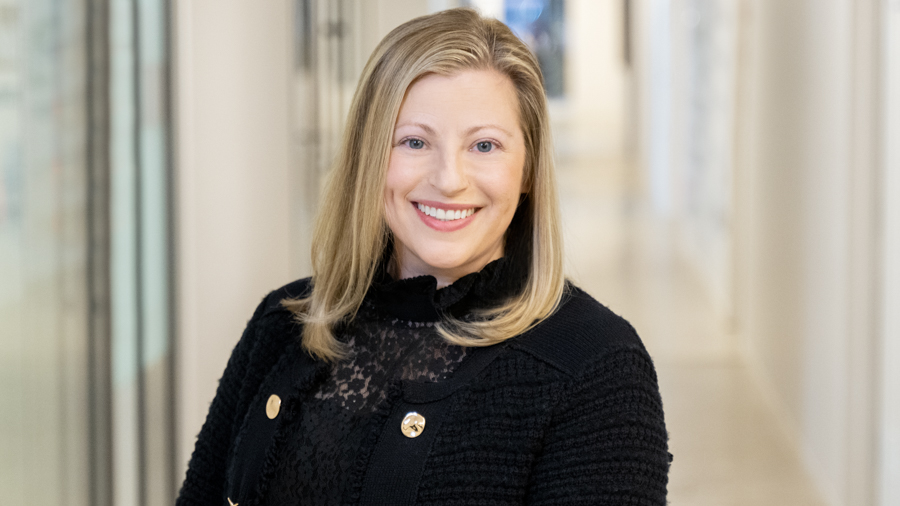
Vice President, Corporate Affairs and Patient Services
ALLSC-US-001215. March 2024
Monia Vial, Senior Vice President, Franchise Head, Rare Disease Business Unit at Ipsen reflects on a conversation with Courageous Parents Network to educate Ipsen colleagues about shared decision-making and potential positive impacts when we better understand how patients, their care advocates and healthcare providers communicate.
Over the last few decades shared decision-making has become an important paradigm shift in healthcare. The concept, coined back in 1982 by the Presidential Commission, was established to foster collaboration between patients and healthcare providers with the purpose of ensuring patients and their families remain at the forefront of their healthcare decisions. True shared decision-making requires a relationship where a patient and their care advocates have a comprehensive understanding of their condition, treatment options, and potential outcomes, while the healthcare providers understand the patient’s preferences, lifestyle considerations and values. As a result, well-informed patients are empowered to have a degree of control in their care experience. Despite the recommendation by the Commission, shared decision-making isn’t always common practice.
I had the opportunity, along with several of my Ipsen colleagues, to explore the complexities of shared decision-making with Jennifer Siedman, Director of Community Engagement at Courageous Parents Network (CPN). Courageous Parents Network is a non-profit organization dedicated to providing resources to parents caring for children with serious medical conditions. In the incredible dialogue, two key factors stood out to me as areas that require our full attention – how we help address decision-making fatigue and understanding the full experience of the patient.
Navigating Decision-Making Fatigue
There is always a level of uncertainty expected with any decision, especially with complex and chronic conditions. The diagnostic odyssey associated with an accurate diagnosis for a rare disease can bring a myriad of new obstacles or outcomes that differ from patient to patient. After a diagnosis, patients and families may struggle to understand the potential outcomes and their choices around how to manage their care. Furthermore, the chronic nature of a rare disease might mean that healthcare providers have difficulty accurately predicting disease progression and response to treatment, further complicating decision-making.
With uncertainty and all the decisions that come with it, fatigue often sets in. Whether a difficult decision or a simple one – an example Jennifer used was “want me to bring you dinner?” – decisions can be daunting. How a care team and support system is able to step in can make a huge difference. Put simply, we must all do our part to reframe questions into statements that provide an out – such as “I plan to bring you spaghetti on Thursday.” Put in a more complex way, we need to consider this in the way we design clinical trials, how we educate about side effects of medicines and anticipating how decisions might align with certain lifestyles, preferences, values and outcome goals.
Understanding the Experience of the Patient and Their Family
In order to anticipate lifestyles, preferences, values and outcome goals, we truly need to understand the experience of the patient over the course of their lives – pre-diagnosis, the journey to a diagnosis and everything afterward that both themselves and their families experienced. Were they dismissed by a doctor? Did they get sent to multiple specialists before an answer? Did the information available leave them without appropriate expectations?
By mapping the full experience of the patient and their family, we can better understand the nuances and anticipate the decisions along the way to better foster an environment of shared decision-making. A metaphor Jennifer used describes shared decision-making as a “driver and passenger”- patients and their caregivers in the “driver” position and HCPs should steer away from instances where a patient may feel like a passenger “along for the ride.” By equipping the “driver” with a thorough understanding of the route and seeking agreement on the desired destination, a healthcare professional can become a trusted partner. Others in the healthcare ecosystem, including pharmaceutical companies, advocacy organizations, policymakers and others, can offer a “seat belt” for the driver with educational materials, clear information about medicines, research funding and other important aspects to provide security.
Decision-making is distinctly between the patient, their care advocates and healthcare providers. However, there is a role for our broader healthcare ecosystem to create an environment where this collaborative approach can flourish. Screening efforts or access to preventive care can provide answers earlier or avoid long diagnostic journeys. Educational resources and support from patient advocacy organizations along with the ability to seek a second opinion can mean more credible information is available for decision-making to occur. Clinical trials and research, availability of multiple treatment options and robust guidelines or management protocols can play a role in providing more options to accommodate lifestyle considerations, preferences, and values.
At Ipsen, we believe in the power of choices being made jointly with patients, their care advocates and their healthcare provider teams to ultimately keep the patient and their family at the forefront of their healthcare journeys. We recognize that progress needs to be made to allow for continuous self-advocacy by patients and their families. We also need to better understand how complex the decision-making process may be at times. We are committed to doing our part by understanding the full patient experience and providing comprehensive information about the risks and benefits of our medicines.

Senior Vice President, Franchise Head, Rare Disease Business Unit
ALLSC-US-001216. February 2024
L. Marie started her career more than 20 years ago helping others access community health programs and healthcare—a skillset she never imagined would eventually be put to use advocating for her own health after being dismissed by her doctors.
It was January 2019 when L. Marie first sensed that something was wrong. She felt much more tired than normal, but chalked it up to the weather—thinking that the cold, dark winter days in Chicago were responsible for her feeling of being rundown.
“As women, we can explain away anything,” says L. Marie. “It took me a while to come to terms that there was something going on and that I needed to start looking for answers.”
When she visited her doctor, she was frustrated that her symptoms were discounted, even after her blood work came back irregular.
“How active are you?” “What’s your diet like?” were the questions her primary care physician asked, dismissing the serious fatigue L. Marie had been experiencing for weeks.
“As givers and caretakers—at home and at work—women give so much, but this was a moment in my life when I finally said, ‘wait a minute, I need to focus on me right now.’”
The fatigue persisted, but so did L. Marie. After pressing her doctor to run more tests, they noticed that she had elevated alkaline phosphatase (ALP) levels which can indicate liver disease or certain bone disorders.1 But an MRI and bone scan confirmed that her bones were strong, and she knew she needed to find out more about liver diseases.
Luckily, L. Marie’s health insurance didn’t require a referral to see a specialist and after doing some research on her own, she made an appointment with a hepatologist. Given her career, she knew how to navigate the healthcare system and within a week, L. Marie was finally in front of a specialist who would be able to give her answers. The diagnosis was primary biliary cholangitis (PBC), which was later confirmed with a liver biopsy, and validated what she had known from the beginning: something was not right.
PBC is a rare, progressive autoimmune cholestatic liver disease in which bile ducts in the liver are gradually destroyed and can inhibit the liver’s ability to rid the body of toxins.2 It is also a disease that predominantly affects women.3
Accepting and Giving Support
“When you’re first diagnosed, you’re thirsty for knowledge,” recalls L. Marie. Unfortunately, she didn’t get support resources from the doctor who diagnosed her – she was instead told to do her own research. She took a proactive approach and reached out to the American Liver Foundation who connected her with a local PBC group.
“There are two dates you remember,” L. Marie reflects on her experience. “The day you were diagnosed and the day you met another person living with PBC. The better day is meeting someone else with PBC because you realize you’re not alone. People living with PBC are all different, and come from different walks of life, different generations, but there is something underneath that links us together—it’s like a sisterhood.”
While L. Marie still finds support among her close friends and family, she takes comfort in knowing she’s not alone. That there are others who are living with PBC and who understand what it’s like to navigate an “invisible” disease and the challenges that come with it.
The Credibility Gap
L. Marie’s story, like so many others, reflects the inherent bias in our healthcare system, especially the inequity that exists for women’s health.
Research shows that women and racial and ethnic minorities are up to 30 percent more likely to be misdiagnosed than white men.4 Women’s health concerns are often chalked up to “daily life” as a caretaker for their family or can be blamed on mental health, weight or lack of diet and exercise. These generalizations not only are dismissive to potential underlying conditions, which can lead to delays in diagnosis and effective treatment, but create a dynamic where someone may not bring up the realities of how they are feeling or even fuel stigmas that exist.
For people with PBC, studies have indicated that because some of the symptoms—like itching and fatigue—are “invisible” there is a fear of being viewed as complaining about the burden or impact of disease on daily life.5
Moving Forward
For L. Marie, she has become the CEO of her own health. She speaks about her experience in hopes of empowering others to do the same. In many ways, she approaches this facet of her life like she does her career.
“This condition isn’t going away,” says L. Marie. “I need to know how I can educate myself and plan for the future while helping others do the same.”
Thankfully, L. Marie was diagnosed with PBC early with her self-advocacy, but there are many others who are not. She hopes that others will have the courage and feel empowered to not give up when advocating for themselves with their healthcare provider and when necessary, to break down the barriers that exist within our healthcare system.
For women who may feel overlooked or ignored by the health system, L. Marie encourages you to “be unwavering in your commitment to advocate for yourself. You know your body best and you deserve answers.”
1https://my.clevelandclinic.org/health/diagnostics/22029-alkaline-phosphatase-alp
2Kimagi T, et al.. Orphanet J Rare Dis. 2008; 3:1
3Galoosian A, et al. 2020. Clinical updates in primary biliary cholangitis: trends, epidemiology, diagnostics, and new therapeutic approaches. J Clin Transl Hepatol. 8(1), pp. 49-60.
4https://qualitysafety.bmj.com/content/33/2/109
Dr. Mónica de Abadal, Head of Medical Affairs, North America at Ipsen shares why she believes it takes everyone in the healthcare ecosystem coming together to close existing gaps and address health inequities in cancer care.
Over the past few decades, we have all witnessed incredible progress in cancer research and care, which brings hope to the millions of Americans who are living with cancer. However, despite scientific advances and a focus on prevention, inequities in cancer persist and social determinants of health (SDOHs) – conditions in which people are born, live, learn, and work – continue to weigh heavily into risk of cancer and outcomes from cancer.1 A recent study reported that up to 75 percent of cancer cases are associated with SDOHs rather than clinical factors and significantly contribute to an individual’s cancer risk, early prevention, and likelihood of survival.2
No person or family impacted by a cancer diagnosis should have a poorer outcome or die because of where they live, what they do, or who they are. This is our obligation as a company – from discovery of new medicines to clinical research and ultimately getting them to the people who need them – and our work at Ipsen focuses on identifying how we can address gaps in care.
Rural Communities
Disparities and structural inequities often disproportionately impact rural communities that have been historically underserved. In fact, more than 46 million Americans are living in rural communities and these individuals are more likely than their urban counterparts to die from cancer.3,4 This is an alarming and devastating statistic given the current state of cancer research and that there are more cancer therapies available than ever before.
This is even more relevant for cancers that are difficult to detect and diagnose early on, like pancreatic cancer. Prevention starts with regular health check-ups, which can be challenging in rural areas where the number of primary care facilities are fewer and waiting times are longer. This in turn, may drive people to wait to see a doctor or underestimate symptoms and prolong diagnosis. And even when a doctor is available, they may not be specialized within a cancer type, knowledgeable about hard-to-treat cancers or comfortable using new treatment options.
As technology evolves, outcomes can improve in rural settings as we can ensure access to tools that will support prevention, early detection, and available treatment options, including helping facilitate participation in clinical trials through use of remote technology. Treatment guidelines for consistency of care and management of adverse events related to treatment, along with telemedicine may also help us better support certain needs of people in rural communities.
Age and Overall Health
Age-related barriers present a unique challenge in the current research and treatment paradigm, especially for elderly populations who have higher incidence rates for cancer yet often face disproportionate barriers.5 Take follicular lymphoma (FL) for example, an indolent, slow-growing cancer that predominately affects older adults, many of whom are more likely to have competing co-existing conditions.6
Older populations are usually not included in clinical trials, and yet, they have the highest incidence of cancer. Access to clinical trials are essential, especially when it comes to data generation for specific co-existing conditions. However, co-existing conditions remains one of the most difficult aspects of clinical trial design where health outcomes like how well a medicine works and its safety profile are generalized. Inclusion and exclusion criteria, as well as involving people living with cancer and their caregivers in the design of studies are an important start.
Yet, our work doesn’t stop once our medicines are approved – in fact, it’s just the start. We have an obligation to follow those medicines and generate real-world evidence (RWE) to ensure we understand the efficacy and safety across even more unique health situations.
Health Literacy
An important reality that we can’t ignore around how health information is communicated. Healthcare providers, especially doctors, are trained on very specific terminology, much of which, is not always understood by the people who need that information the most. When it comes to making treatment decisions, managing side effects, and improving quality of life, individuals living with cancer and their families can often be lost amongst complex terminology not fully understanding the condition, their options or potential outcomes.
What if a person speaks English as a second language? In those situations, understanding health information can become a two-way barrier that also impacts how a person with cancer explains their experiences – a vital aspect of the doctor-patient relationship, especially when it comes to shared decision making and advocating for individual needs. This can lead to treatment discontinuation or in a worse case, disease progression or poor quality of life.
At Ipsen, we believe that developing plain language summaries explaining our medicines and research is imperative. We also believe in the importance of resources being made available in multiple languages to ensure information is available to make informed decisions.
A multitude of barriers exist beyond the few I acknowledged. To complicate matters more, our health system is complex and inequities, biases and barriers are deeply ingrained.
Change starts with all of us. At a microlevel, we are focused on recruiting a diverse workforce with the aim to reflect the diversity of the communities we serve. At a macrolevel, we must listen to the experiences and perspectives of people impacted by cancer.
Sustainable change requires collaboration and our focus is central to that goal. We work with different bodies across the healthcare ecosystem – from peers in our own industry, regulatory authorities and patient advocacy organizations to healthcare providers, hospital systems, payers, and policymakers – to mine for solutions and increase access for all. Most importantly, we also listen and learn from people living with cancer and their families to better understand the lived experiences, identify their needs and aim to provide the cancer community with support.